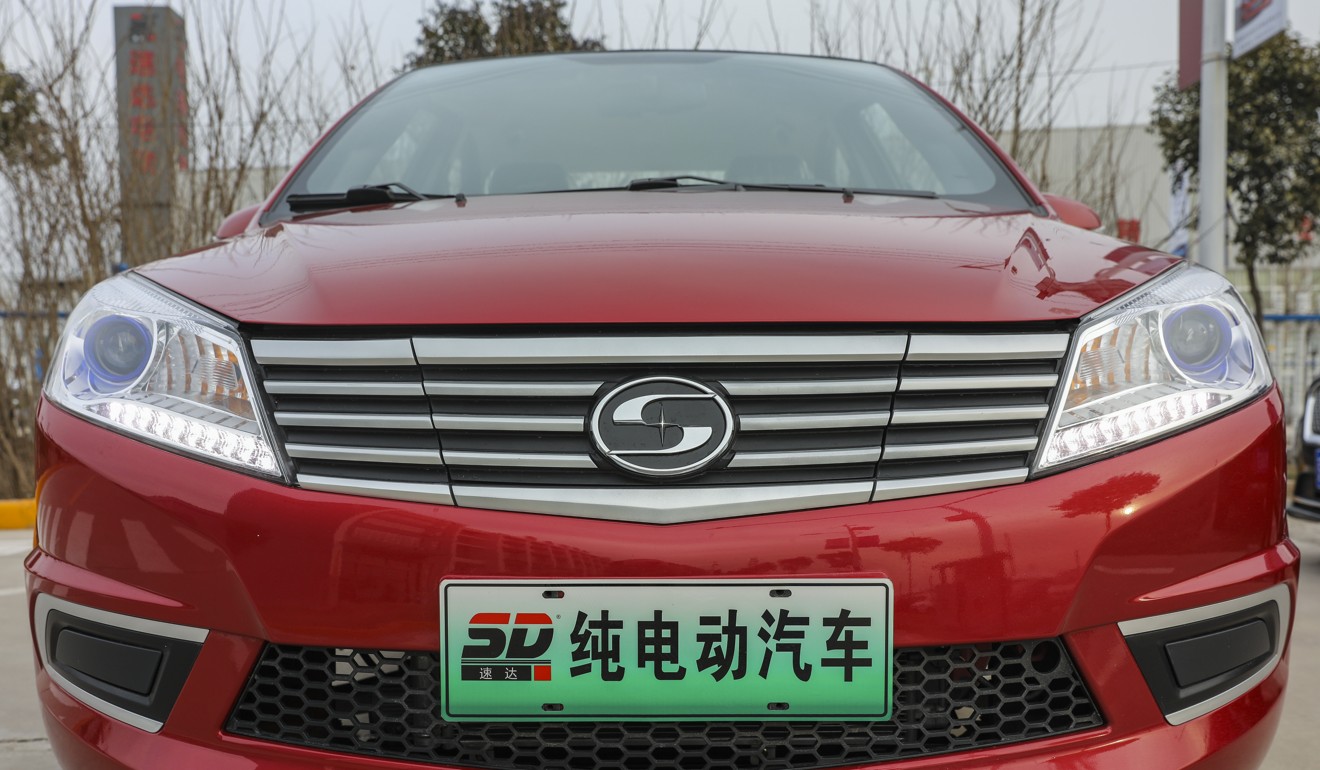
China’s plans to dominate hi-tech sector with ‘Made in China 2025’ plan hit a stumbling block as US trade war takes its toll
- Production in a number of advanced manufacturing sectors dropped sharply late last year as US tariffs took effect
- Tighter US laws and regulations are likely to further impede progress of ‘Made in China 2025’ plan
Beijing’s push to dominate hi-tech industries in the next decade under the “Made in China 2025” plan has been hit by the US trade war with a number of advanced manufacturing sectors experiencing weakening demand.
Production of industrial robots fell by 12.1 per cent in December from a year earlier after a drop of 7.0 per cent in November, according to data published by the National Bureau of Statistics on Monday.
Meanwhile, growth in the new-energy car sector, which has been heavily subsidised by the government, slowed to 15.5 per cent in December from 24.6 per cent in November.
Production of integrated circuits, the semiconductors that power smartphones, computers and other electronic devices, as well as high-end industrial and military products, also fell by 2.1 per cent in December, although this was an improvement from November’s decline of 7 per cent.
Overall, output in China’s industrial sector, which includes manufacturing, mining, utilities and power generation, and makes up around 40 per cent of the nation’s gross domestic product, grew 6.2 per cent last year, a drop from 6.6 per cent in 2017.
Industrial growth last year was mainly supported by a rise in the mining sector, which offset a slowdown in the manufacturing and utility sectors, according to an analysis by Nomura.
The ongoing trade war with the United States was identified as the main cause of the fall in advanced industrial output as high US tariffs cut into demand, causing business and consumer confidence to shrink and so perpetuating a downward spiral in economic activity.
In December, Chinese exports dropped 4.4 per cent compared with a year earlier, the biggest decline since December 2016 – which in turn was the slowest figure recorded since 1990.
Beijing had hoped that promoting advanced product manufacturing and exports, it would help transform its economy to dominate the hi-tech sector.
However, its efforts have been hampered by weakening global and domestic demand and the trade war with the US.

In particular, there are signs that capital expenditure in robot manufacturing, one of the sectors that Beijing wants to lead, is shrinking, according to Iris Pang, Greater China economist at ING.
“These are like robots that are used in packaging or logistics,” Pang said. “Producers of these products might be considering making them elsewhere [to avoid tariffs] because of the trade war.”
Beware ‘black swan’ and ‘grey rhino’ threats to stability, Xi warns cadres
Beijing laid out its hi-tech ambitions with the “Made in China 2025” plan in 2015, which aims to support and promote 10 cutting-edge industries – including robotics, aerospace, 5G communications, new materials and new energy vehicles – replacing imports with local products and building global champions able to take on the Western tech giants.
The plan triggered a backlash from the US and the European Union, China’s biggest trading partners, who complained that Beijing’s state-subsidised industrial strategy was unfair to foreign firms and, worse, would lead to market distortions.
The US has already imposed tariffs on US$250 billion in Chinese goods – and has threatened duties on double that value of products, responding to what Washington has claimed as unfair trade practises in China.
Beijing has retaliated with tariffs on US$110 billion in US goods targeting politically important industries such as agriculture.
Following a meeting in December between US President Donald Trump and China’s President Xi Jinping, the leaders of the world’s two largest economies agreed to a truce while they sought an agreement within three months.
Is US right to cry foul about forced tech transfer to do business in China?
However, analysts believe even if the two nations have reached an agreement in March with no additional tariffs, manufacturers may still contemplate making their products in other locations that are less sensitive politically.
“Of course there is a cycle in consumer demand for cars or smartphones,” Pang said. “We may not want to buy a new phone now. But manufacturers think long-term [on where to locate their production base].
“For robotics makers, they could be thinking, maybe Vietnam is a better choice after all. Hence they’re cutting down on capital expenditure [in China].”
Angus Chan, a Shanghai-based automobile industry analyst at Bank of Communications International, said that the growth of new energy vehicles was mainly supported by government subsidies, but there are unlikely to be similar support for the passenger car market this year.
Car sales, a key indicator of Chinese consumption, dropped last year for the first time in almost 30 years.
“The government has ramped up spending to support different industries [because of the slow-down in the economy],” Chan said. “To also boost subsidies in traditional auto sector would add a lot of pressure on the budget deficit.”
More importantly, growing US hostility to Beijing’s hi-tech ambitions is likely to hold back China’s progress, according to a report by JP Morgan.
Has Beijing done enough to stop slowdown in China growth?
Reforms in US laws on foreign investment, which strengthened the regulations on inbound foreign investment and limited the transfer of emerging and foundational technologies through purchases of US start-ups could dramatically slow down Beijing’s plan to increase its market share in the hi-tech sector, JPMorgan argued.
“Non-tariff actions tend to be more specifically targeted to sectors that are critical to China’s ambitions in technology and of manufacturing upgrade, including 5G communication, information technology, AI and robotics, biomedicine, and new energy,” said the analysis continued.
“The confrontation will increase the challenge to China’s efforts to upgrade its manufacturing and service sectors, and its efforts to restore productivity growth and achieve a sustainable catch-up in the long run.”

